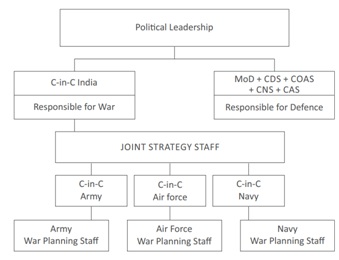Context
Chief of Defence Staff General Bipin Rawat held a meeting in the backdrop of concerns about the proposed model of integrated theatre commands.
About the integrated theatre commands
- It is a unified command under which all the resources of the Army, the Navy and the Air Force are pooled, depending on the threat perception.
- The commands could be geographical that will look at a border with a particular country or thematic, as a command for all maritime threats.
- Several nations in the world have theatre commands, including the United States and China.
- The idea of creating an integrated tri-Services command in India had been recommended at various levels after the Kargil conflict.
- Gen Rawat was appointed Chief of Defence Staff to head the integrated command.
What is the proposal under discussion?

- A model with four to five integrated tri-Services theatre commands is under discussion, with each command headed by a three-star officer.
- This officer, the theatre commander, will report to the Chiefs of Staff Committee (COSC), which, as the name suggests, includes the three Service Chiefs, and is headed by the CDS as its permanent chairman.
- The Service chiefs currently have all the operational control over their forces; operational powers will now move to the COSC.
- Each of these commands will have the needed assets from all three forces.
The proposed commands are:
- Maritime Theatre Command: It will take care of all the maritime security needs of the country on both the eastern and the western seaboards, and will include air strike assets and amphibian forces of the Army.
- Air Defence Command: It will be mandated with air defence across the country and beyond. The fighter jets will have reconnaissance and surveillance assets as well.
- Land-based commands: Two or three land-based commands are proposed. If there are two commands, there will be one each for India’s borders with China and Pakistan.
- Logistics Command: There will be a Logistics Command, which will have the logistics of all the Services under one person; and there will be a Training and Doctrine Command so that all Services work under a common doctrine and have some basic common training.
Existing commands in India
As of now, the three forces have 17 commands between them.
- The Army has seven commands: Northern, Eastern, Southern, Western, Central, Southwestern and Army Training Command (ATRAC).
- The Air Force has seven as well: Western, Eastern, Southern, Southwestern, Central, Training, and Maintenance commands.
- The Navy has three: Western, Eastern and Southern, of which Southern is largely about training.
- Tri-Service Command: There are two existing tri-Service commands as well — the Andaman and Nicobar Command (ANC), which is headed by rotation by officers from the three Services, and the Strategic Force Command, which is responsible for India’s nuclear assets.
CDS and its need
- The creation of the Chief of Defence Staff (CDS) is a start to defence reforms. This would improve joint manship in peacetime.
- Major problems:
-
- historical lack of unified warfighting strategy formulation at the apex military level
- the unclear division of responsibility and resources between service Chiefs and Commandersin-Chief (C-in-Cs)
- the differing natures of command and control between the three services, which manifest as differences in structural organisations.
- Treating India as one unified theatre can reduce these problems.
- This announcement was followed by the creation of a new Department of Military Affairs (DMA) to be headed by the CDS.
|
